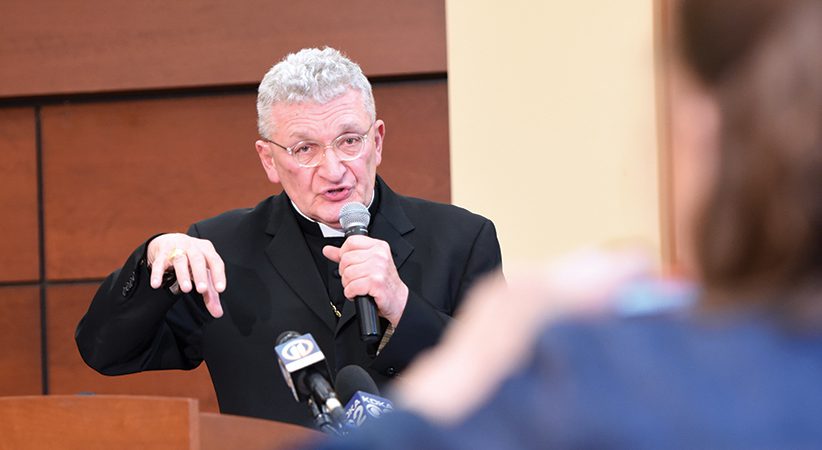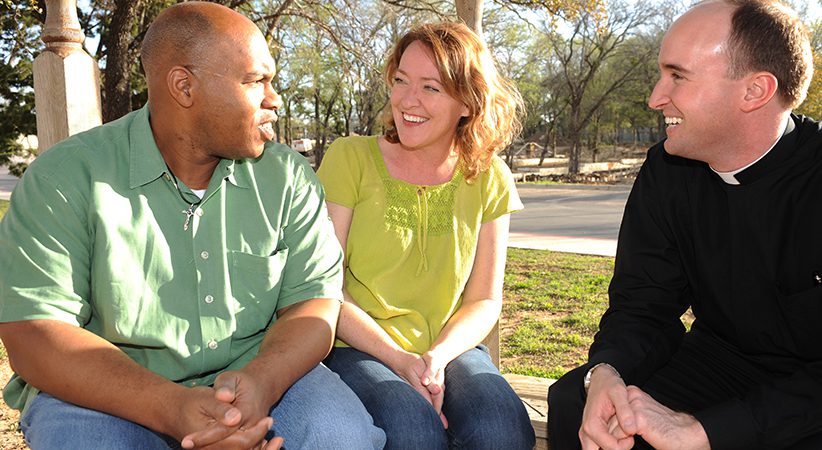Becoming a Prayerful Presence
Saints and mystics can help inspire an intimate conversation with the Lord
Susan Muto Comments Off on Becoming a Prayerful Presence
No matter how often or under what circumstances priests pray for the People of God — be it in times of tribulation or triumph, when they are brought low by sorrow or elated by joy — they strive not only to say prayers in accordance with ritual elegance but also to be present to the divine Presence. Praying is not so much what priests do as it is who priests are. Prayerful presence is not a technique they master but their living expression of a timeless call given to them by the Lord.
The power of prayer reveals itself in the personal and communal lives of these ordained men of God in cooperation with the grace bestowed upon them by virtue of their vocation. They want to be such faithful disciples that prayer becomes to their spirit what breath is to their body. To pray only when duty demands would be for priests to die spiritually, just as to stop breathing would be to pass away physically.
Praying All Ways
To become a prayerful presence is in effect to pray “all ways.” Ceaseless prayer is not a task priests accomplish nor is it a technique they master. It is a way of being that opens them to the ever-flowing mystery of God’s nearness to us. Priests experience prayer more as a way of listening than speaking, more as a gift they receive than a duty they fulfill.
Both in “The Book of Her Life” and in “The Way of Perfection,” St. Teresa of Ávila (1515-82) shares the secret of how to pray always. Prayer for her began and ended with her commitment never to stray from devotion to the sacred humanity and divinity of Jesus. He is for her the “living book” (BL, 26:5) from whom she learned the meaning of redemptive suffering.
Prayer has to be an expression of friendship with God. It does not result in a flight from reality but in a way of living that enables priests and the people they serve to be with God in the harshest and happiest of times. To her divine friend, St. Teresa says: “You make things so possible that You manifest clearly there’s no need for anything more than truly to love You and truly to leave all for You, so that You, my Lord, may make everything easy. … They who really love You, my Good, walk safely on a broad and royal road” (“The Book of Her Life,” Chapter 35, Paragraphs 13-14).
In the Chapters 26 to 42 of “The Way of Perfection,” she confirms that “it is a great thing to have experienced the friendship and favor [Our Lord] shows toward those who journey on this road and how he takes care of almost all the expenses” (Chapter 23, Paragraph 5).
………………………………………………………………………………………………………………………………………………………………………………
St. Teresa of Ávila’s Famous Bookmark
St. Teresa of Ávila and the many Carmelite mystics and masters of spirituality she inspired had no doubt that unceasing prayer is the most efficacious way to make our whole life a mirror of Christ’s salvific mission, author Susan Motu observes.. When obstacles threaten to deter priests from this aim, it would behoove them to ponder the words and sentiments expressed in St. Teresa of Ávila’s famous bookmark prayer:
Let nothing disturb you,
Let nothing frighten you.
All things pass away:
God never changes.
Patience obtains all things.
One who has God
Finds one lacks nothing.
God alone suffices.
These rough, unrhymed lines were found in St. Teresa’s breviary after her death. Slight in length as they are, they led her to the final and fullest realization of her vocation. They conveyed the truth taught by every priest, with and without words, that God never changes and that God alone suffices.
……………………………………………………………………………………………………………………………………………………………………………….
On this practical note, she confirms that there is nothing parsimonious about the generosity of God. More is given than we asked to receive or thought we deserved, a sentiment with which priests would readily concur.
Following this way of prayer as an intimate conversation with the Lord who loves them enables priests to stay true to their calling in Christ, never to judge themselves or others too harshly, and to exude in every apostolic activity as much affability and understanding as possible: “In such a way that everyone you talk to will love your conversation and desire your manner of living and acting, and not be frightened and intimidated by virtue” (“The Way of Perfection,” Chapter 41, Paragraph 7).
No day is so good that priests do not need to pray; no day is so bad that prayer cannot give them the strength they desire to bear it.
This integration of contemplation and action happens when priests die to the illusion that their functional ego is all-powerful. How liberating it is to shed the imprisoning restrictions of egocentricity and acknowledge one’s dependency on the Trinity for everything. Experiences of this depth propel priests to move from silent adoration to humble service, from worship to work.
Practicing the Prayer of Presence

Wikipedia/Public Domain Image
Brother Lawrence of the Resurrection (1614-91), a Carmelite friar, and a superb spiritual director, encourages every follower of Christ to pray not only at special moments but in the mundane events that comprise one’s everyday life in the world. When priests attend in quiet vigilance and gentle reverence to the here and now, prayer becomes an integral part of their life in the parish and the wider world. Moment by moment, in the richness of the ordinary and at high peaks of ritual, they abandon themselves to God. They attend in every activity to the radiant witness God wants them to give.
In his counsels to priests and people, Brother Lawrence offers several steps essential to the how-to of practicing the prayer of presence, saying to those with ears to hear:
Do not seek consolations from this practice. Do it because you love God more than yourself.
Stay recollected with Christ in the center of your soul and fear nothing.
Place your trust in God and let go of your cares.
When fears arise, cling to the Lord with all your strength.
Remember how pleasing to God prayers of trust and inner adoration are.
However flighty your mind is, reign it in and return to God.
Renounce for God’s sake all that is not in accord with your calling to the priesthood.
Make of your heart an oratory where you can withdraw from time to time to converse with Jesus as fervently and intimately as possible.
Practice the presence of God when you are active and when you are at rest.
Be convinced that God is as close to you in sickness and suffering as when you enjoy good health.
Let this way of being become second nature to you and never hesitate to ask God for the grace you need to be faithful to your priestly call.
Sanctity to Service
The fruits of becoming a prayerful presence prevent priests from sinking into arrogance and activism out of touch with their commitment to discipleship. Whatever they do — cooking a meal, writing a letter, teaching a class, visiting the sick — they do out of love for God and a desire to make this love manifest. To see God’s face in every person, event and thing they encounter enable them to remain faithful disciples despite daily pressures.
A wonderful teacher in this regard is St. Thérèse of Lisieux (1873-97). Three characteristics summarize her prayer life and account for its flow from sanctity to service. The thread that ties these traits together is Thérèse’s decision, following her conversion, to let Jesus possess her heart and to give her all to him.
The first, to be disinterested, means that she refused to put herself in the center of anyone’s attention. Her self-effacement was total.

The second, inclusive love, proved itself not by sweet words but by tireless deeds. Her life became “one act of love” without undue reliance on sensible feelings. To believe that she had done her best to accomplish God’s will constituted her entire joy.
The third, discretion, prompted Thérèse to hide her sufferings from others and even, so to speak, from God, for fear that were he to see them, he would suffer on her account. Should she be found worthy to attain temporal graces from him, for example, for her family of origin and her religious community, that was at God’s discretion. Her faith assured her that no suffering was ever wasted in the Mystical Body of Christ. Love and prayer were the best means for correcting her faults as well as trustworthy safeguards against future failings.
Thérèse believed that the light of God within her was meant to radiate through her personality into the situations in which she found herself. Her story teaches us that God transforms us by grace so that we can bring the fruits of this transformation to others. The spirituality of a saint like Thérèse inspires priests and people to move from a fragmented to an integrated life centered on the virtues of trust, simplicity, patience and generosity. Only if we live these virtues to the full can the seeds of spiritual childhood planted in us by God bear lasting fruit. Then Thérèse’s prayer can become our own: “Jesus … draw me into the flames of [your] love … unite me so closely to [you] that [you] live and act in me.”
Intimacy with the Trinity
The spiritual nourishment priests receive from integrating contemplation and action culminates in the grace of intimacy with the Trinity — a gift given in seed fashion every time someone makes the Sign of the Cross.

A Carmelite mystic who spent her short life celebrating this truth is St. Elizabeth of the Trinity (1880-1906). In her oft-quoted prayer to the Triune God she adores, she says, “Help me to forget myself entirely that I may be established in you.” She invites us to remember that we are children of God called to delve so far into the depths of the divine that it feels as if we are already in eternity. She prays, “Give peace to my soul, make it … your beloved dwelling, your resting place.”
Elizabeth identifies with the experiences her Beloved had to undergo for the sake of our salvation. Nondescript as our lives may be, she assures us that Christ’s light is in us and that we, too, may be praise of his glory.
This call to unity deepens every time priests pray to spend their lives listening to Jesus and becoming docile to his leading. In sickness and in health, during the dark nights of their soul and at the dawn of a new day, they can heed Elizabeth’s example and fix their gaze on the Cross. To lose themselves in the immensity of the Infinite in no way destroys their uniqueness. To bury themselves with Jesus in the tomb is to rise with Jesus and witness daily to the Paschal Mystery.
Elizabeth’s great hope was that this consuming fire, this spirit of love, would come upon her and “create in [her] soul a kind of incarnation of the Word: that [she] may be another humanity for him in which he can renew his whole mystery.” Elizabeth believed that only when the Word becomes flesh in us can we live and die as an epiphany of the Lord.
That is why it is impossible to separate how priests pray from the style of praise and appreciation in which they work. They celebrate their vocation by thanking God for his favors, for promises fulfilled and hopes yet to come.
In the swirling sea of everydayness, there are many broken shells, bits of seaweed and scattered debris. Although one may be inclined to seek a cleaner beach, this is where God wants his disciples to walk.
……………………………………………………………………………………………………………………………………………………………………………………
Along the Path
Susan Muto’s book “Pathways of Spiritual Living” (Epiphany, $16) focuses on the universal call to holiness and considers these steps along the path of spiritual living: silence, solitude, prayer, reading, meditation, journal-keeping, contemplation and service.
…………………………………………………………………………………………………………………………………………………………………………………….
Instead of trying to fit our notion of what God wills into a rigid mold of perfection, priests teach God’s people to accept life as it is, warts and all! They grow in the conviction that God watches over the Church and provides for her abundantly. They value every person entrusted to their care. When life becomes burdensome, they ask the Lord to take their yoke upon his shoulders (cf. Mt 11:30) and to silence their disquiet. They try daily to interweave their abiding with the Lord in contemplation with their willingness to serve others in the splendor of the sacramental life.
Prayer makes them more responsive to every movement of the Spirit in whose presence they learn to love without limit. In down-to-earth language, with compassion, humor and vivid imagery, they show that the most genuine sign that one loves God is love of neighbor. They pray not merely for personal pleasure or contentment but to help Christ bring his redemptive graces to every believing and seeking soul.
SUSAN MUTO, Ph.D., is dean of the Epiphany Academy of Formative Spirituality in Pittsburgh and author of “Gratefulness: The Habit of a Grace-Filled Life” (Ave Maria Press, $15.95).





